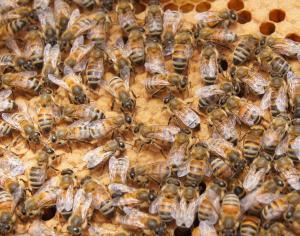Research links mite to destructive honeybee virus
Involves researchers from CTAHR and Sheffield University in the United Kingdom
University of Hawaiʻi at MānoaContact:
Ethel Villalobos, (808) 956-2445
Researcher, College of Tropical Ag and Human Resources
Miles Hakoda, (808) 956-3093
Director of Communication Services, College of Tropical Ag and Human Resources
Researcher, College of Tropical Ag and Human Resources
Miles Hakoda, (808) 956-3093
Director of Communication Services, College of Tropical Ag and Human Resources
Posted: Jun 11, 2012
In the June 8, 2012 issue of the journal Science, researchers from the United Kingdom along with Dr. Ethel Villalobos and Scott Nikaido of the University of Hawai‘i at Mānoa Honeybee Project reported observations of large-scale change in the honeybee viral landscape. Their findings could help uncover the mysteries surrounding the devastating colony collapse disorder in honeybees.
The investigation describes how the spread of the Varroa mite in the Hawaiian Islands has led to an increased prevalence of the destructive disease Deformed Wing Virus (DWV) among local colonies. Since the mite arrived in the islands, DWV has increased its presence in honeybee colonies from approximately 6-13% to 70-100%. Additionally, transmission via the mite results in a million-fold increase in the number of DWV particles infecting each individual bee.
Researchers from the College of Tropical Agriculture and Human Resources at UH Mānoa and Sheffield University in the UK also showed that Varroa decreases the genetic diversity of DWV, with one strain coming to dominate over all others in areas where Varroa is well established. This trend was first seen on O‘ahu, the island on which Varroa was initially discovered. Varroa was discovered one year later on the Big Island, and the same pattern of dominance by the same strain of DWV was observed.
Due to the rapid worldwide spread of Varroa, little was known about the natural landscape of honeybee viruses prior to the mite infestation. The recent arrival and subsequent spread of the Varroa mite across parts of—but not all—the islands of the Hawaiian archipelago presented a unique opportunity. In Hawai‘i, it was possible to study the early phases of the evolution of the viruses in association to the Varroa mites.
The researchers showed that the spread of Varroa in Hawai‘i has caused DWV, a virus of low prevalence and minimal impact in Varroa-free areas, to emerge as a lethal pathogen. They hypothesize that the association of Varroa and DWV mirrors changes that occurred in other parts of the world and that the interaction between the Varroa mite and certain strains of DWV may be a contributing factor in the deaths of millions of honeybee colonies worldwide.
Although deformed wing virus can also be transmitted across generations of bees, from parents to offspring, honeybees are more likely to express serious signs of infection, such as crumpled, unusable wings, when the viral transmission involves Varroa. Understanding the role of the Varroa mite and changes in the viral strains of DWV is crucial to the protection of these important pollinators.
For more information, see the UH Honeybee Project’s web site at www.uhbeeproject.com.

